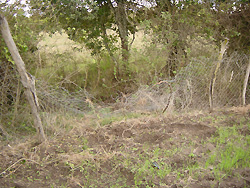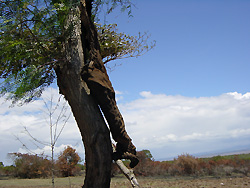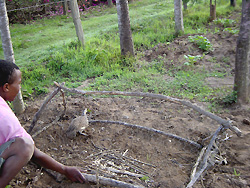(3)
 |
| Photo 1: A farm fence damaged by elephants. In the foreground is germinating wheat that was trampled by the elephants. |
 |
| Photo 2: The trunk of a dead elephant tied to a tree in an attempt to deter elephants from a farm. |
 |
| Photo 3: Polyethylene flags hung on a farm to deter birds and antelopes. The vibrations and sounds caused by blowing winds deter birds and antelopes. |
 |
| Photo 4: A trap for yellow-necked spur fowl. Inside is a trapped yellow-necked spur fowl. The white granules are maize seeds used as bait. |
The study was conducted from October 16, 2004 to January 20, 2005. The fieldwork was carried out in Mahiga ‘B’ village in Nyeri District, Kenya.
1. An outline of the villagers livelihood
People began settling in Mahiga ‘B’ village in 1980. The land occupied by the village was formerly a livestock-rearing ranch owned by a white settler. Each resident was allocated land measuring 4.6 acres. The settlement process has been slow with much of the land in the village being unoccupied. The residents are basically farmers who cultivate maize, kidney beans, Irish potatoes and wheat as their main crops. Being a semi-arid area that receives just over 500 mm of rain per year, the success of a cropping season depends on the amount of rainfall. Crop failure rates are high. Villagers also keep livestock such as cattle and sheep but also goats, although on a smaller scale. Income from the sale of milk constitutes an important source of income for the villagers, although this is also highly dependent on rainfall. Additional income is obtained from the sale of sheep or goats. A negligible number of the villagers have permanent employment, with a majority of the men engaging in irregular low-paying jobs. Other men engage in casual labor within the village, such as digging, weeding, and fence repairs. The women are predominantly farmers, with a few engaging in other economic activities such as teaching and casual labor in the village.
2. Background of the human-wildlife conflict
The village is bordered to the north by Solio ranch, a livestock-rearing ranch. The ranch provides an appropriate habitat for a diverse range of wildlife including elephants, buffaloes, rhinos, elands, giraffes, bush pigs, cheetahs, hyenas, and other species. To the east the village is bordered by Sangare village, which in turn borders Sangare ranch, a livestock rearing ranch whose natural vegetation also provides an appropriate habitat for elephants, bush pigs, buffaloes, etc. Wildlife residents or transient animals from the livestock ranches invade the village farms, attacking cultivated crops and damaging infrastructure, leading to social and economic losses to the farmers.
A serious conflict of interest exists between the farmers, the ranch owners and the government over this situation. The ranches derive economic profits from the presence of wildlife while the farmers incur social and economic loses. The government is committed to wildlife conservation because of the immense contribution it makes to the country’s GDP through tourism.
3. Crop damage and coping strategies
The fieldwork conducted from October 2004 to January 2005 revealed that the conflict situation in the study area is more complicated and urgent than previously perceived. Thirteen bird species and twelve species of mammals attack cultivated crops at different stages of growth: sowed seeds, emerging cotyledons, first leaves, flowering parts, vines, immature pods of kidney beans, young tubers and mature crops. Attacks on crops by wildlife occur both during the day and at night. To successfully cultivate crops the villagers have to be vigilant day and night from the day of sowing to the day of harvesting, a period as long as 6 months in the case of maize, 4 months for Irish potatoes, 4 months for wheat and 3 months for kidney beans. This is effectively impossible considering the fact that villagers have to engage in other activities such as grazing, firewood collection and drawing water, limiting the time during which they can guard against wildlife during the day. Nighttime is normally for resting, but mature maize, Irish potatoes and wheat are attacked at night by bush pigs, elands and elephants, giving villagers sleepless nights. Adequate rainfall gives hope of a bumper harvest to the villagers, but wildlife acts as a limiting factor. Infrastructure such as fences is also damaged (Photo 1).
The villagers’ strategies for coping include applying the black carbon residue from dry cells to maize seeds to deter attacks by birds, erecting scarecrows to deter antelopes, and tying animal parts on trees to deter elephants (Photo 2: Photograph taken on October 30, 2004). The landowner informed me that he had tied the trunk on the tree to warn other elephants that his land was dangerous. On December 20, elephants invaded the farm, trampled the immature wheat that was growing, ate leaves from the pepper tree in the photo, and took away the trunk. The landowner in turn cut down the tree so that it would not attract elephants to his farm anymore, hung up polyethylene flags to deter birds and antelopes (Photo 3), chained dogs in the farm to deter birds and antelopes, kept guard, beat metallic objects at night, lit fires in the farm at night, laid traps (Photo 4), replanted maize seeds several times in the season to out-compete birds, sowed maize seeds in a nursery and transplanted them to the farm to avoid attacks by birds, etc. Though the success of these methods is limited, the fact that the farmers apply them indicates that they perceive some reprieve from their use.
4. Future research plan
Additional data about the relationship between the villagers and the Kenya Wildlife Service (KWS) will be collected. KWS is charged with conserving and managing Kenya’s wildlife resources as well as protecting people and their property from wildlife. I will also investigate the relationship between the villagers and both Solio and Sangare ranches. In addition, I will explore the villager’s cohesiveness in matters of human wildlife conflict and collect data on household demographics, which are currently missing.




 21st Century COE Program
-Aiming for COE of Integrated Area Studies-
21st Century COE Program
-Aiming for COE of Integrated Area Studies-